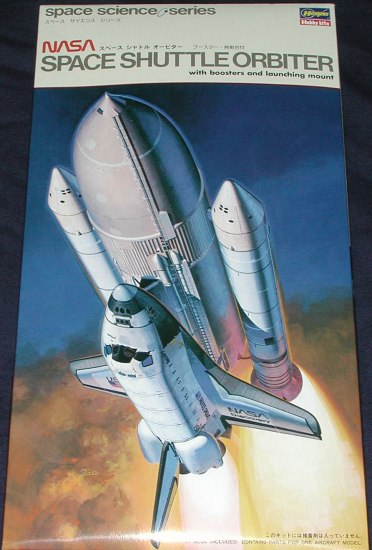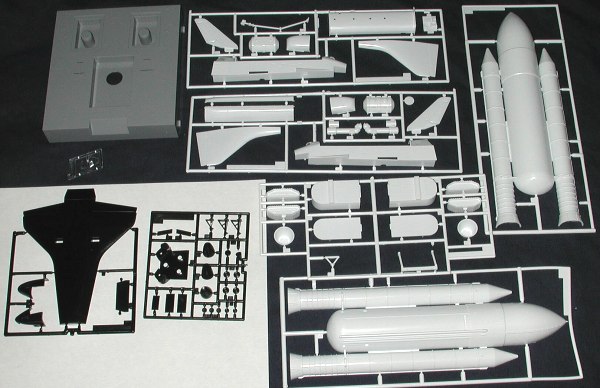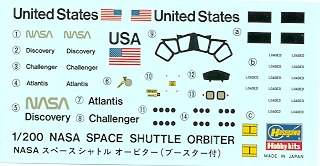
|
KIT: |
Hasegawa 1/200 Shuttle with boosters |
|
KIT # |
SP 134 |
|
PRICE: |
@$30.00 |
|
DECALS: |
Challenger, Atlantis, Discovery, Endeavour, Columbia |
|
REVIEWER: |
|
|
NOTES: |
Includes the crawler |

|
HISTORY |
The first Shuttle was the only one that never flew into space. Enterprise was used for gliding and landing tests so was never really fully equipped for space travel. This was followed by Columbia, Challenger, Discovery and Atlantis. Following the loss of Challenger during STS-51L in 1986, a fifth shuttle, Endeavour, was built, making its first launch in 1992, six years later.
Recently, the Columbia joined Challenger as shuttles lost
during operations. As sad as it is to have loss of life, space exploration and
travel is one of the most hazardous undertakings that there is, with a myriad
of things that could go wrong and jeopardize the crew. However, we need to
take these losses in stride, learn from them and go on. Compared to the number
of people who died in the early days of aviation, Space Shuttle operations are
comparatively safe, and should be continued.
|
THE KIT |

Hasegawa has two basic boxings of the Space Shuttle. One is of the orbiter itself, which comprises the upper central two sprues and the black sprues on the lower left. With the inclusion of the boosters, the entire STS is offered. This kit also includes the crawler on which the shuttle is delivered to the launch site.
I'm really unsure of just how old a kit this is, but the instructions are dated 1994 so that would make it about 10 years old. It is typical of Hasegawa kits, consisting of finely engraved panel lines and the tendency of stuffing all of the parts into a single plastic bag. These are then stuffed into a box into which you cannot properly replace all the sprues once they are taken out!
As you can see, several of the parts are molded in black, supposedly to make the model paint free. However, once one gets through with the usual gluing and filler, it will need painted anyway. The Orbiter is a rather simple construct, and the builder does have the option of displaying it on its landing gear. This may seem like an odd option to include when one has the boosters, but the Orbiter is available as a separate kit unto itself. A full payload bay is offered with the option of having it open. A payload and the Canadian-developed arm are included to full the bay. With the stack (which is what the orbiter and boosters are often called), these bits will be relegated to the spares box along with the landing gear. There is no cockpit, typical of a 1/200 kit. I'm not sure if the bay is even required, but I'd install it anyway to ensure proper stiffness of the Orbiter.
The rest of the 'stack' is in two halves, a very easy way of doing things, but one that makes it difficult to tackle any seam problems on the external tank and boosters. The rest of the kit is the crawler and this is a simple construct of 9 rather large pieces. Again, in 1/200, there is no reason to have any major detail as it would be so grossly out of scale as to look most odd.
 Instructions are typical
Hasegawa and give Gunze paint references. The basic colors are black and white
for the Shuttle stack and grey for the crawler. However, we all know that these
colors are subject to change. The most recent Columbia mission had a coating on
the booster that was orange and other colors change with the missions. There are
tons of web sites dedicated to the Shuttle so references will be easy to find.
Decals are provided for all of the Orbiters. This boxing adds the Columbia and Endeavour (not shown) to the lot as the Orbiter model itself only has the other
three on the decal sheet. NASA markings are the 'wurm' variety. NASA has since
returned to the original NASA insignia. Decals are typical of Hasegawa in
that they are thick and the white is ivory. However, one is stuck with them as
no aftermarket replacements are available.
Instructions are typical
Hasegawa and give Gunze paint references. The basic colors are black and white
for the Shuttle stack and grey for the crawler. However, we all know that these
colors are subject to change. The most recent Columbia mission had a coating on
the booster that was orange and other colors change with the missions. There are
tons of web sites dedicated to the Shuttle so references will be easy to find.
Decals are provided for all of the Orbiters. This boxing adds the Columbia and Endeavour (not shown) to the lot as the Orbiter model itself only has the other
three on the decal sheet. NASA markings are the 'wurm' variety. NASA has since
returned to the original NASA insignia. Decals are typical of Hasegawa in
that they are thick and the white is ivory. However, one is stuck with them as
no aftermarket replacements are available.
|
CONCLUSIONS |
With this kit, you can now have your Space Shuttle in 1/288, 1/200, 1/144, and 1/72 scale. The kit looks quite easy to build, though painting it will be a bit of a challenge, especially the bands around the solid boosters. Thankfully a black decal is provided for the window area.
|
REFERENCES |
There are a zillion websites, but the best one to start with is http://www.hq.nasa.gov/office/pao/History/shuttlehistory.html
If you would like your product reviewed fairly and quickly by a site that has nearly 200,000 visitors a month, please contact me or see other details in the Note to Contributors.